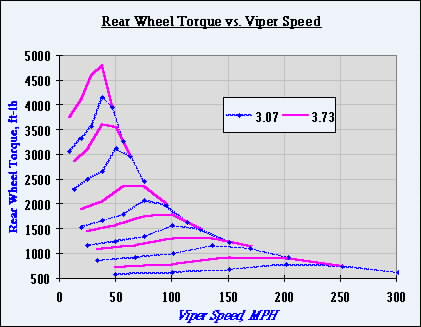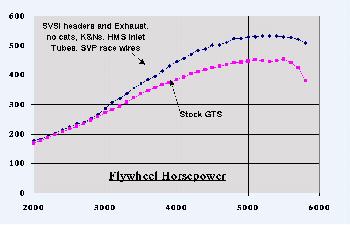What are the benefits of a rear gear swap?
Changing the rear end gear to a numerically higher (like going to a 3.73 from the stock 3.07 ) ratio will increase the torque multiplication of the motor, resulting in more rear wheel torque.
Rear-wheel torque equals:
Engine Torque x Transmission Gear Ratio x Rear Differential Gear Ratio
It seems as though Dodge has been underrating the power/torque numbers for their Vipers. They claim 490 ft-lb of engine torque for a new GTS, but chassis dynos have shown a consistent 450 ft-lb of rear-wheel torque. Add in 13 % for "driveline losses" (the power lost between the motor's flywheel and the rear wheel due to gear friction, rotational inertia, etc), and a stock GTS engine is making almost 520 ft-lb of peak torque!
For a stock Viper GTS, peak rear-wheel torque in first gear is:
450 ft-lb x 2.66 First gear ratio x 3.07 rear end gear = 3670 ft-lb
So, if you swap in a 3.73 rear differential gear, peak torque at the rear wheels in first gear is now:
450 ft-lb x 2.66 x 3.73 = 4460 ft-lb
Yep, a 21% increase in rear wheel torque without touching the motor! That's the same as keeping the stock gear and modifying the engine to increase its torque output to 630 ft-lb (Take away 13% for driveline losses and you get 546 ft-lb).
546 ft-lb x 2.66 x 3.07 also = 4460 ft-lb
You will gain 21% more "pull" in every gear with a 3.73 gear swap. This modification is indeed one of the best "bangs for the buck" you can do to your Viper. The difference in acceleration is phenomenal.
What is the trade-off? You have to shift sooner. Now the redline in first gear comes at 48 mph instead of 58 mph. Second gear maxes out at 63 mph instead of 76 mph. The trade off is WORSE FUEL ECONOMY and even more TRACTION problems.
As we all know, it's already challenging to get the car to "hook up" in first gear on street radials. Imagine doing it now that there's 21% more torque available. A pair of rear slicks would help here. Assuming perfect traction, you can shave almost half a second from the car's 0 to 60 mph elapsed time by doing this gear swap (3.07's to 3.73's).
Cruising at 70 mph is 6th gear now spins the motor at 1700 RPM instead of 1390 RPM (as if fuel economy is a factor when considering the purchase of a Viper). No more 22 mpg.
The biggest trade-off is the maximum speed will be limited, depending on the modified nature of the motor and how "steep" of a rear gear you go to. A stock GTS can go about 185 mph (Mach 0.25), which corresponds to the motor spinning 5400 RPM in fifth gear, with about 950 ft-lbs of rear wheel torque counter-acting the aerodynamic drag forces on the car. Air drag keeps the car from going any faster.
Here's a plot of how rear wheel torque varies with speed, and it gives you a visualization of where the gear changes occur. You can see how the 3.73 (red plot) gives you more torque at the rear wheels compared to the 3.07s (blue plot), but requires a sooner shift point. The blue line corresponding to fifth gear near 185 mph reads about 950 ft-lbs. (Sorry that the graph is a bit small)

Put in a 3.73 ring and pinion, and figure out at what point 950 ft-lbs is available (my calculator is now getting warm) Guess what? Fifth gear is now only good to 168 mph, at which point there's a little over a thousand ft-lb of grunt at the rear wheels. So you're still accelerating. But you have to go into sixth or else you'll hit the rev-limiter. The jump to sixth gear drops you down to 4100 RPM, where there's only 800 ft-lb of rear wheel torque available. Since you need 900+ ft-lb, you'll SLOW DOWN. Your max speed is now officially 168 mph. (Top speed is pretty much only a bragging-rights thing anyway, for those of us who have a survival instinct )
Here's a table that should give you a general idea of how rear gearing affects top speed:
| Rear Gear Ratio | Top Speed (Stock motor) | Transmission and RPMS |
| 3.07 (stock) | 185 MPH | 5th Gear, 5400 RPM |
| 3.31 | 185 to 190 MPH | 5th Gear, near redline |
| 3.54 | 177 MPH | 5th Gear, 6000 RPM |
| 3.73 | 168 MPH | 5th Gear, 6000 RPM |
| 4.10 | 153 MPH | 5th Gear, 6000 RPM |
Now, let's see how this works on a modified Viper. I've got dyno data on a modified GTS, which has upgraded plug wires, HMS inlet tubes, SVSi headers and exhaust, and no cats. The graph below shows the horsepower difference compared to a stock Viper).

This GTS is making 70ft-lb more rear wheel torque than stock. With the stock 3.07 gear, this car will probably do 200 mph at 5900 RPM in fifth.
| Rear Gear Ratio | Top Speed | Transmission and RPMS |
| 3.07 (stock) | 200 MPH | 5th Gear, 5900 RPM |
| 3.31 | 189 MPH | 5th Gear 6000 RPM |
| 3.54 | 177 MPH | 5th Gear 6000 RPM or 6th Gear 4050 RPM |
| 3.73 | 168 MPH | 5th Gear 6000 RPM or 6th Gear 4040 RPM |
| 4.10 | 200 MPH | 6th Gear 5300 RPM |
And here's a table that shows vehicle speeds corresponding to a redline shift-point: (Note that all five gears are used in a quarter-mile run with 4.10s)
| Rear Gear | 1st | 2nd | 3rd | 4th | 5th | 6th |
| 3.07 | 58 | 76 | 114 | 151 | 204* | 302* |
| 3.31 | 54 | 70 | 105 | 140 | 189 | 280* |
| 3.54 | 50 | 66 | 99 | 131 | 177 | 262* |
| 3.73 | 48 | 63 | 94 | 124 | 168 | 249* |
| 4.10 | 44 | 57 | 85 | 113 | 153 | 226* |








